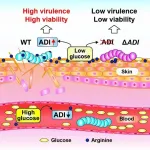(Press-News.org) Research conducted in U.S. national parks has focused largely on five iconic parks, with more than a third of academic papers focused on Yellowstone National Park, researchers from North Carolina State University found in a new analysis.
They also found that the number of publications per year increased during the 1990s and 2000s, but has dropped since 2013. The findings, published in the journal Conservation Science and Practice, were drawn from an analysis of nearly 7,000 published, peer-reviewed studies conducted at U.S. designated national parks since 1970.
"Looking at the data was a surprise and perhaps a wake-up call," said the study's lead author Jelena Vukomanovic, assistant professor of parks, recreation and tourism management at NC State. "Overall, there's more research being published than ever before, but we're actually seeing a decline in publications of research conducted in the national parks."
In the study, researchers used the Web of Science database to analyze academic journal articles on national parks published between 1970 and 2018. While the National Park Service manages more than 400 properties including battlefields and national seashores, the researchers focused on 59 designated national parks. They excluded research on three newly established parks, and did not include reports published outside of peer-reviewed journals.
"National parks are large, relatively intact natural areas that serve conservation objectives and provide aesthetic and other connections between people and nature," Vukomanovic said. "We wanted to look at what research was being conducted in national parks and what kind of biases there might be in our understanding of these unique and special places."
They found more than half of all studies since 1970 have focused on five national parks - the parks that see the greatest number of visitors per year. Yellowstone accounted for 36.2% of studies; the Everglades represented 6.8%; Great Smoky Mountains accounted for 6.2%; Glacier represented 5.6%; and Yosemite was at 5.3%.
"We need to understand that this is the context behind the conclusions we come to about our landscapes," said study co-author Josh Randall, graduate student in parks, recreation and tourism management at NC State. "Many of the findings - and their management implications - that we may apply broadly come from a small number of parks."
The location of parks near research universities wasn't necessarily linked to the amount of published research on them.
"We know that well-funded researchers can travel to interesting places that have unique phenomena," Vukomanovic said. "We found some relatively understudied parks are close - within a day trip distance - from a lot of research universities. This is a call for future work on the drivers of research, which could help both park and university administrators identify and address barriers."
More than half of studies were conducted in parks in northwestern forested mountains. Seventeen percent of studies were done in North American deserts, 10% were in eastern temperate forests, tropical wet forests represented 7% of studies and marine west coast forests were at 6%.
"The national parks of the east represent extraordinary biodiversity and cultural heritage," Vukomanovic said. "How can we bolster research activity there?"
Life sciences research - and ecology and evolutionary biology studies in particular - made up the majority of park research, representing 60% of total publications.
Physical sciences and mathematics research made up 25% of studies, with the largest share of research in that field going to the earth sciences. Social and behavioral science research made up 8% of studies; engineering made up 3%; and education and multidisciplinary research made up 3%. The arts and humanities represented less than 1% of total research.
Researchers said availability of funding could be playing a role in the decline in publications per year since 2013, and should be studied further.
Federal agencies in the United States was the most commonly cited source of research funding. Notably, more than a quarter of research funding sources were based international internationally.
"These are the world's living laboratories," Vukomanovic said. "This interest from international sources speaks to the fact that everyone benefits from the research and knowledge that's being garnered at the national parks. There could be opportunities for that to grow. How can we make it easier for international collaborators to work in national parks?"
Researchers said increasing availability of data from the national parks could spur research.
"This analysis offers a comprehensive overview that can be built on to shape future work, to identify and address research gaps and determine funding priorities," Vukomanovic said. "It's a blueprint to consider for the future."
INFORMATION:
The study, "Research trends in U.S. national parks, the world's 'living laboratories,'" was published online in Conservation Science and Practice on March 30, 2021. The authors were Jelena Vukomanovic and Joshua Randall. The work was supported by the National Park Service award P17AC01439.
-oleniacz-
Note to editors: The abstract follows.
"Research Trends in U.S. national parks, the world's 'living laboratories"
Published online March 30, 2021, in Conservation Science and Practice
Authors: Jelena Vukomanovic and Joshua Randall
DOI: 10.1111/csp2.414
Abstract: U.S. national parks are essential public assets for preserving natural and cultural resources and for decades have provided natural laboratories for scholarly research. However, park research, and how it may be biased, has not been inventoried at a national scale. Such a synthesis is crucial for assessing research needs and planning for the future. Here, we present the first comprehensive summary of national park research using nearly 7,000 peer-reviewed research articles published since 1970. We report when and where these studies occurred, what academic disciplines were most represented, and who funded the research. Our findings show that publication rates increased rapidly during the 1990s and 2000s, but since about 2013 have declined. Over half of the studies occurred in five parks, with Yellowstone representing over a third of all studies, followed by Everglades, Great Smoky Mountains, Glacier, and Yosemite. Nearly half of the studies occurred in the Northwestern Forested Mountains ecoregion. The life sciences, particularly ecological studies, contributed the majority of park research, although the earth sciences dominated several arid ecoregions of the West. Federal agencies funded the largest proportion of research, followed by U.S. universities, non-profit organizations, federal programs (mainly the National Science Foundation), state agencies, and private industry. Over a quarter of the research was supported by international sources. Recent declines in scholarly output suggest that national park research directions and funding opportunities should be examined.
Forty million people living in the Kanto region of Japan, which includes Tokyo, may be able to blame a meandering ocean current for increasing hot and humid summers, according to an analysis conducted by an international team of researchers. The Kuroshio Current flows north, bringing warm water from the tropics to Japan's southern coast. Since 2017, however, it has meandered off its traditional path, turning south before continuing north again. Now, scientists have found that the "large meander" is responsible for the uptick in humidity and temperature.
The researchers, from Tohoku University in Japan and the University of Hawaii in the United States, published ...
Osaka, Japan - Streptococcus pyogenes is one of the most important bacterial causes of human skin infections. If S. pyogenes invades deep into the tissue, it can cause life-threatening illnesses, such as sepsis and toxic shock. With its limited supply of carbohydrates, the skin is generally an effective barrier against infection and not a good surface for the survival of S. pyogenes. To survive successfully and invade deep into the tissue, bacteria must be able to find a source of nutrients and also evade the skin's immune defenses.
Now, an international ...
Scientists from Tomsk Polytechnic University jointly with Russian colleagues and researchers from Technical University of Denmark the first time have experimentally proved the existence of a two-dimensional (2D) curved flux of plasmonic quasiparticles, a plasmonic hook. A flat 2D hook is smaller than a 3D hook and possesses new properties, due to them, the researchers consider it as the most promising transmitter in high-speed microoptical circuits. The research findings are published in Applied Physics Letters (IF: 3,597; Q1) academic journal.
Electrons transmit information in existing calculation devices. The scientists suppose if electrons are replaced ...
New research shows how drinking sugary beverages early in life may lead to impaired memory in adulthood.
The study, published today in Translational Psychiatry, also is the first to show how a specific change to the gut microbiome -- the bacteria and other microorganisms growing in the stomach and intestines -- can alter the function of a particular region of the brain.
According to the Centers for Disease Control and Prevention, sugar-sweetened beverages are a leading source of added sugars in Americans' diets. Nearly two-thirds of young people in the United States consume at least one sugary drink each day.
Neuroscientist Scott Kanoski, associate professor of biological sciences at the USC Dornsife College of Letters, Arts and Sciences, has studied the link between ...
LA JOLLA, CA--The faster-spreading B.1.1.7 variant of SARS-CoV-2 first detected in the United Kingdom, the coronavirus that causes COVID-19, is quickly on its way to becoming the dominant variant of the virus in the United States, according to a study from scientists at Scripps Research and the COVID-19 test maker Helix.
The findings, which appear today in Cell, suggest that future COVID-19 case numbers and mortality rates in the United States will be higher than would have been otherwise. The analysis suggests that the variant, which has been detectable in an increasing proportion of SARS-CoV-2 samples, is 40-50 percent more transmissible than SARS-CoV-2 lineages that were previously dominant. Other studies have found ...
Transport Network Companies (TNCs) not only increased road congestion but were also net substitute for public transit reducing PT ridership by almost 9%
The reduction in private vehicle ownership due to TNCs was insignificant
Research findings can provide valuable insights for transportation policy and regulation
Singapore, 31 March 2021 - Transport Network Companies (TNCs) or ridesharing companies have gained widespread popularity across much of the world, with more and more cities adopting the phenomenon. While ridesharing has been credited with being more environmentally friendly than taxis and private vehicles, is that really the case today or do they rather contribute to urban congestion?
Researchers at the Future Urban Mobility ...
The younger generations are willing to put their money where their mouth is when it comes to sustainable living. In a study questioning both commitment to sustainable behaviors and willingness to trade better pay to work for a more sustainable-minded company, the surveyed young adults in Japan made their preferences clear.
The results were published on Jan. 31 in a special issue of the Journal of Cleaner Production focused on achieving the END ...
Until now, researchers have believed that dark energy accounted for nearly 70 percent of the ever-accelerating, expanding universe.
For many years, this mechanism has been associated with the so-called cosmological constant, developed by Einstein in 1917, that refers to an unknown repellant cosmic power.
But because the cosmological constant--known as dark energy--cannot be measured directly, numerous researchers, including Einstein, have doubted its existence--without being able to suggest a viable alternative.
Until now. In a new study by researchers at the University of Copenhagen, a model was tested that replaces dark energy with a dark matter in the form of magnetic forces.
"If what we discovered is accurate, it would upend our ...
Nagoya University researchers have identified a gene that plays a crucial role in regenerating neurons of African clawed frog tadpoles, which has an unusually high capacity for nerve regeneration. Their study, recently published in the journal iScience, showed that introducing the gene into mice with spinal cord injury (SCI) led to a partial recovery of their lost motor functions. These findings could contribute to the development of a new therapy for SCI, which often causes a person to experience permanent and severe physical and neurological disabilities.
Repairing spinal cord injuries in humans and other mammals is difficult, partly because ...
Cancer patients generally have a higher thrombotic risk than the population at large. This risk is influenced on the one hand by patient-specific factors and the cancer itself and, on the other, by the cancer treatment, that is to say surgery, radiotherapy, or specific chemotherapeutics, which can increase the risk.
In the last few years, immune checkpoint inhibitors have increasingly been used to treat many different types of cancer. By activating the immune system against the tumour, these drugs improve the prognosis for patients with malignant melanoma, ...




